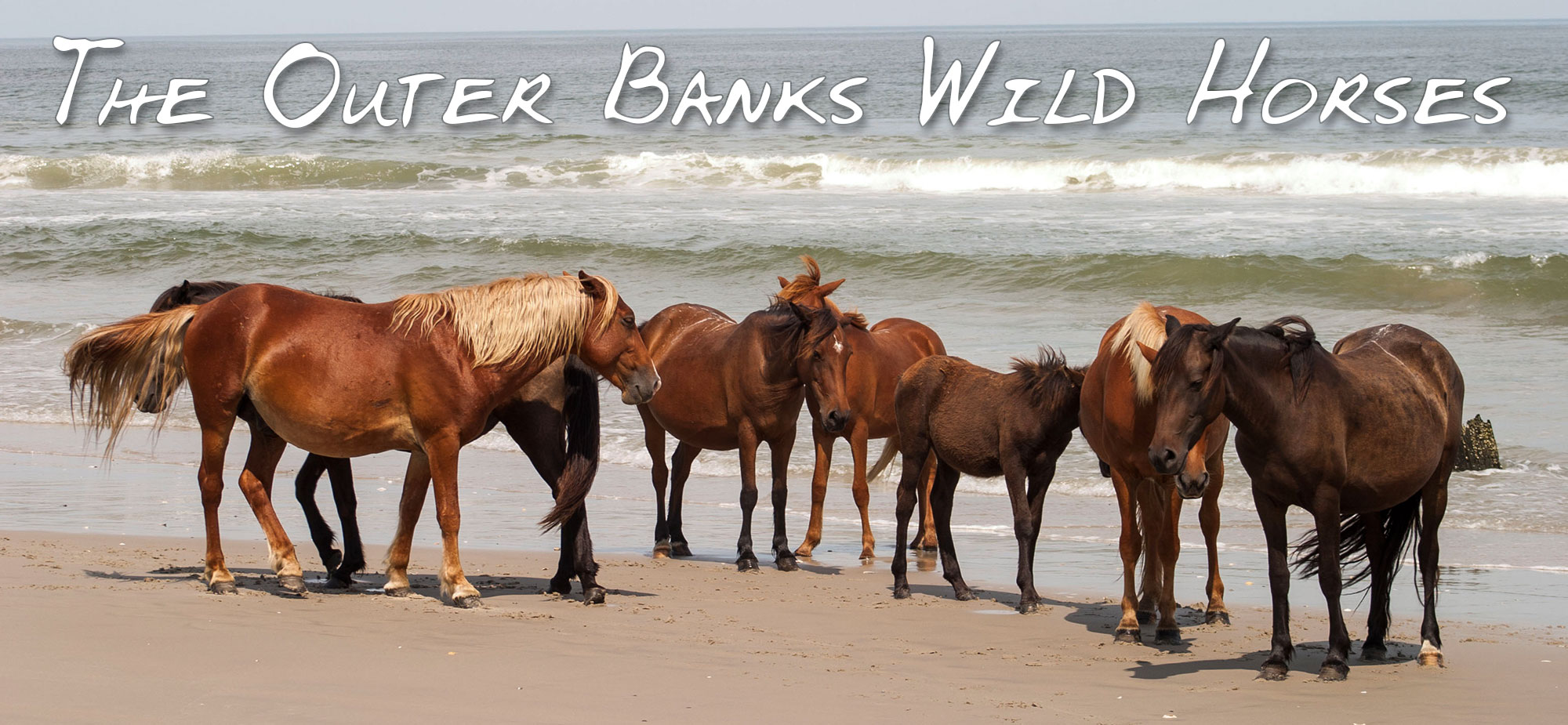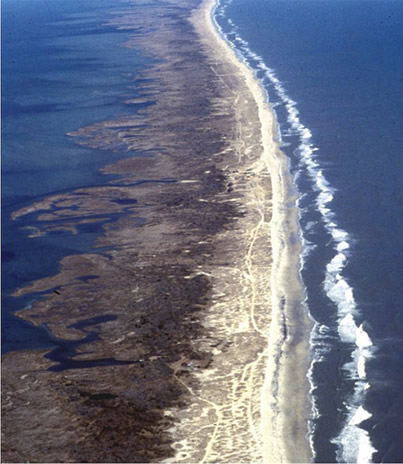
Outer Banks
 The Outer Banks (also known as OBX) are a chain of islands that cover half the coast of North Carolina (United States). The islands separate the Currituck Sound, the Albemarle Sound, and the Pamlico Sound from the Atlantic Ocean. This paradisea, a 200-mile-long strip, is home to herds of feral horses, more than 400 species of birds, Atlantic Blue Marlin, sand dunes with peeks higher than 90 feet, and many more wildlife curiosities. Ocean, sunset, wildlife, beaches, temperate climate, they all make it a perfect place for vacation and recreation. Because of its beauty and in order to preserve it, many areas were made national parks.
The Outer Banks (also known as OBX) are a chain of islands that cover half the coast of North Carolina (United States). The islands separate the Currituck Sound, the Albemarle Sound, and the Pamlico Sound from the Atlantic Ocean. This paradisea, a 200-mile-long strip, is home to herds of feral horses, more than 400 species of birds, Atlantic Blue Marlin, sand dunes with peeks higher than 90 feet, and many more wildlife curiosities. Ocean, sunset, wildlife, beaches, temperate climate, they all make it a perfect place for vacation and recreation. Because of its beauty and in order to preserve it, many areas were made national parks.
OBX History
If nature and history are the driving force of your travels, there are several protected areas in this region that might pique your interest for discovery and adventure.
Cape Hatteras National Seashore
Cape Hatteras National Seashore preserves 70 miles long shore that stretches from Bodie Island to Ocracoke Island.
 This idyllic location is a place with rich, mysterious, and at times violent history. Going back to 16th century, a time of first European colonists, one discovers that many ships were sailing towards these shores, but more than five thousand ships were wrecked and never reached the shore. Because of the very dangerous currents and the high number of wrecks that have occurred there, the Outer Banks are also known as the Atlantic Cemetery (or "Graveyard of the Atlantic"). Historical evidence can be found in The Atlantic Cemetery Museum which is located in Hatteras Village. Currents in these parts are so dangerous that in 1874, the U.S. Lifesaving Service (U.S. Coast Guard today) initiated building of lifesaving stations along the Outer Banks. If the red flag is flying, the tides are too strong for swimming.
This idyllic location is a place with rich, mysterious, and at times violent history. Going back to 16th century, a time of first European colonists, one discovers that many ships were sailing towards these shores, but more than five thousand ships were wrecked and never reached the shore. Because of the very dangerous currents and the high number of wrecks that have occurred there, the Outer Banks are also known as the Atlantic Cemetery (or "Graveyard of the Atlantic"). Historical evidence can be found in The Atlantic Cemetery Museum which is located in Hatteras Village. Currents in these parts are so dangerous that in 1874, the U.S. Lifesaving Service (U.S. Coast Guard today) initiated building of lifesaving stations along the Outer Banks. If the red flag is flying, the tides are too strong for swimming.Three Visitor Centers provide service in the area.
The Bodie Island Visitor Center is located in the north, next to the Bodie Island Lighthouse.
The Hatteras Island Visitor Center and Museum of the Sea is located in the Cape Hatteras Light keeper's quarters, in Buxton, North Carolina.
Ocracoke Island Visitor Center is located in Ocracoke, North Carolina near the Ocracoke Lighthouse.
Throughout the year visitors can attend tours and exhibits bringing an insight into the maritime heritage and natural history of the Outer Banks.
 Piracy, robbery, and criminal violence were common in centuries following initial colonization, and Outer Banks, especially Ocracoke Island, was no exception. Among many famous pirates who operated in this area was Blackbeard (Edward Thatch), the most notorious pirate among English-speaking nations. He was killed in 1718 in Ocracoke Inlet. There are numerous books depicting his adventurous life while Ocracoke Island Visitor Center also has so much to offer on the subject.
Piracy, robbery, and criminal violence were common in centuries following initial colonization, and Outer Banks, especially Ocracoke Island, was no exception. Among many famous pirates who operated in this area was Blackbeard (Edward Thatch), the most notorious pirate among English-speaking nations. He was killed in 1718 in Ocracoke Inlet. There are numerous books depicting his adventurous life while Ocracoke Island Visitor Center also has so much to offer on the subject.Fort Raleigh National Historic Site
Fort Raleigh National Historic Site preserves the location of Roanoke Colony, the first English settlement in the USA, founded in late 16th century by Sir Walter Raleigh acting on orders of Queen Elizabeth I.
 It was established on Roanoke Island, today's Dare County, North Carolina. The colonists disappeared during the Anglo-Spanish War. Why has this question has remained unanswered to this day, prompting the nickname "The Lost Colony."
It was established on Roanoke Island, today's Dare County, North Carolina. The colonists disappeared during the Anglo-Spanish War. Why has this question has remained unanswered to this day, prompting the nickname "The Lost Colony." What happened to the colony was a topic of numerous books. The Lost Colony, written and performed to commemorate the original colonists, is the longest running outdoor drama in the United States and its theater acts as a cultural focal point for much of the Outer Banks. Some theories claim colonists sailed back to Europe, others think they were captured by the Spaniards, while yet there are those who think they were killed by local inhabitants. However, most recent findings indicate they might have split into two groups and assimilated with local Native American communities, which is easy to believe, as who wouldn't want to live in this paradise.
Colonial Spanish Mustang
Though Spaniards might not be responsible for the Lost Colony, they certainly are for the aboundance of wild horses in Outer Banks, and America in general. Contrary to a possibly common impression that Native Americans had been using horses before the European colonisation, they are in fact descendants of Spanish Mustangs brought by ships to the New World, there being no horses in Americas before Spaniards. Actually there were horses before Columbus, but they became extinct more than ten thousand years ago.
Today, these beautiful creatures are once more in danger. There is an ongoing fight for the preservation of wild horses, but some representatives are trying to use our tax money to fund slaughtering of these exquisite animals.
Jockey's Ridge State Park
Jockey's Ridge State Park is a North Carolina state park in Dare County. It's located in Nags Head and includes the tallest active sand dune system in the eastern United States. The park is open year round, with free admission and parking. It attracts many visitors, making it the most popular park in the entire NC park system. Besides Ranger-led programs, available are nature trails, a sound access, and picnic areas. If you're a photo enthusiast make sure to watch the sun setting over the sound. Also, bird watching and kite-flying are some of the favorite activities that take place in the park. Furthermore, the park's visitor center features a museum, where visitors can find about cultural and natural history of the park.
Mountains-to-Sea Trail
The Mountains-to-Sea Trail (MST) is a long-distance hiking trail, that runs from Clingman's Dome in the Great Smoky Mountains (here it connects to the Appalachian Trail ) to the Jockey's Ridge State Park in Outer Banks.
The MST is the highest elevation, long-distance trail in the eastern United States, the highpoint being Mount Mitchell at 6,684 feet.
North Carolina Aquarium on Roanoke Island
The North Carolina Aquarium on Roanoke Island is a 68,000-square-foot (6,300 m2) facility where visitors can explore NC's wildlife through several exhibits, each dedicated to a unique ecosystem of the state. While one exhibit houses the largest collection of sharks in the state along with many other fish species, another one features alligators, turtles, fish, and river otters. More courageous ones can touch a stingray, a white-spotted bamboo shark, or a sea star in another exhibit appropriately called Close Encounters.
Pea Island National Wildlife Refuge
Pea Island National Wildlife Refuge is located on Pea Island and other smaller islands comprising the Outer Banks. The refuge's main purpose is to provide a habitat for migratory birds (like the greater snow geese , waterfowl, shorebirds, raptors, etc.), and other endangered and threatened species. The refuge contains ocean beach, dunes, upland, fresh and brackish water ponds, salt flats, and salt marsh, all open to those who wish to experience wildlife firsthand. There are more than 365 species of birds, 25 species of mammals, 24 species of reptiles, and five species of amphibians. Among these are concentrations of ducks, geese, swans, wading birds, shore birds, and raptors.
Wright Brothers National Memorial
Wright Brothers National Memorial, located in Kill Devil Hills, North Carolina, commemorates the first successful, sustained, powered flights in a heavier-than-air machine. Designated a National Historic Landmark on January 3, 2001, the memorial's visitor center, designed by Ehrman Mitchell and Romaldo Giurgola, also hosts a range of exibits and features.
Outbank Adventures
Piracy, civil wars, wrecking ships , it's all part of history. You can learn about them in local museums. People coming to Outer Banks mostly spend their time enjoying their vacations. There are over 600 outer banks vacation rentals to choose from for staying and few hotels, the top being Sanderling Resort. You can explore Outer Banks by land, water, or sky, on foot, by hummer, or helicopter, fly, walk, ride, or dive. There are over a dozen parks and historic sites and landmarks you can visit, and numerous sightseeing tours, from dolphin sightseeing, wild horse tours, fishing, parasailing, golf courses, surfing, windsurfing, shipwreck scuba diving, and other adventures. There are family and kid friendly activities, dozens of restaurants, sporting and other events all year round. Though being a popular tourist location, the best thing is that OBX is not overly touristy and has plenty of unspoiled and secluded beaches. It is one of the top locations in USA for relaxation, honeymoons, family vacations and adventure. Peak season is spring and autumn, but trust us when we say : you will have fantastic time whenever you come to OBX! If there is only one thing you can do in OBX, we recommend an all year round activity, Wild Horse Adventure Tours, the top rated activity in Corolla, NC, and the most reviewed activity in the whole Outer Banks area! It encompasses some of the most exciting things about OBX: off-road hummer drive through sand beaches and wildlife, encounters with free roaming wild horses, beautiful and diverse sceneries and opportunities to take photos, and all that while enjoying with your partner, family, friends, or co-workers. Whether you are on your romantic vacation or on a team building trip, this adventure provides unique experience. In most common reviews of past adventurers you will hear words like: fantastic, excellent, great, awesome! Trust us, such will be your Outer Banks experience as well!
Selected reading
- D. Stick (2000). Graveyard of the Atlantic: Shipwrecks of the North Carolina Coast. North Carolina, The University of North Carolina
- J. C. Harrington (1949). Archeological explorations at Fort Releigh national historic site. The North Carolina Historical Review. North Carolina Office of Archives and History
- C. H. Whedbee (1966) Legends of the Outer Banks and Tar Heel Tidewater. John F. Blair
- J. Alexander, J. D. Lazell (2000) Ribbon of Sand: The Amazing Convergence of the Ocean and the Outer Banks. UNC Press Books
- D. Frankenberg (2012) The Nature of the Outer Banks: Environmental Processes, Field Sites, and Development Issues, Corolla to Ocracoke. Univ of North Carolina Press